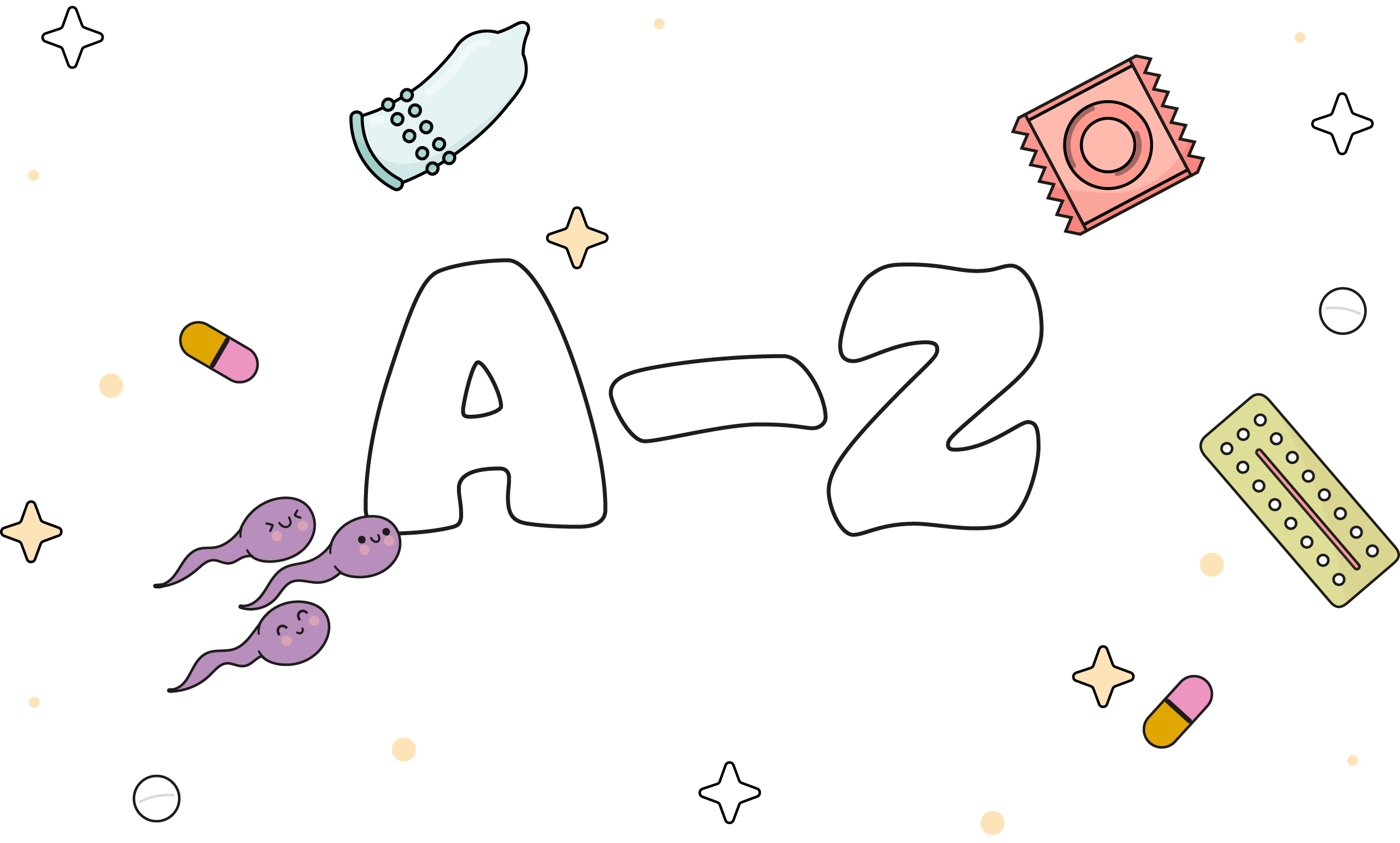
Abstinence
Choosing not to engage in sexual activity.
Aphrodisiac
A substance or activity that enhances sexual desire.
Anorgasmia
Difficulty or inability to achieve orgasm.
Birth control
Methods used to prevent pregnancy, such as condoms, birth control pills, or intrauterine devices (IUDs).
Barrier Methods
Barrier methods are contraceptives that physically block sperm from reaching an egg. Examples include condoms (male and female), diaphragms, cervical caps, and contraceptive sponges. They’re popular among young people for being easy to use, accessible, and offering protection against both pregnancy and sexually transmitted infections.
Bisexual
A person who is attracted to both males and females.
Bacterial vaginosis
A common vaginal infection caused by an imbalance of bacteria in the vagina.
Consent
Giving permission for any sexual activity. Consent must be freely given, reversible, informed, enthusiastic, and specific.
Condom
A barrier method of contraception made of thin latex or other materials, used to prevent pregnancy and reduce the risk of sexually transmitted infections (STIs).
Contraception
Methods used to prevent pregnancy.
Clitoris
A highly sensitive organ located at the top of the vulva, involved in sexual arousal and pleasure.
Diaphragm
A shallow, dome-shaped device made of silicone that is inserted into the vagina before sex to cover the cervix and prevent sperm from reaching the uterus.
Dental dam
A thin, square piece of latex used as a barrier during oral sex to reduce the risk of transmitting STIs.
Dyspareunia
Painful sexual intercourse, which can have various causes such as physical issues, psychological factors, or relationship problems.
Delayed ejaculation
Difficulty or inability to ejaculate, despite sexual stimulation, which can be caused by physical or psychological factors.
Erectile dysfunction (ED)
The inability to achieve or maintain an erection sufficient for sexual intercourse.
Ejaculation
The release of semen from the penis during sexual climax.
Oestrogen
A group of hormones primarily responsible for the development and regulation of the female reproductive system.
Endometriosis
Endometriosis is a long-term condition where tissue similar to the lining of the womb grows in other places, such as the ovaries and fallopian tubes.
Erogenous zones
Areas of the body that are particularly sensitive to sexual stimulation and can contribute to arousal.
Foreplay
Physical and emotional acts that lead to sexual arousal and can include kissing, touching, and other intimate activities.
Fertility
The ability to conceive and produce offspring.
Fetish
A sexual attraction or fixation on a specific object, body part, or activity.
Female condom
A barrier contraceptive worn inside the vagina to prevent pregnancy and reduce the risk of sexually transmitted infections (STIs).
Gender identity
A person’s internal sense of their own gender, which may differ from their assigned sex at birth.
Gonorrhoea
A common sexually transmitted infection (STI) caused by the bacterium Neisseria gonorrhoeae, which can infect the genitals, rectum, and throat.
Genitalia
The external reproductive organs, including the penis, scrotum, vulva, and clitoris.
Gynaecologist
A medical doctor specializing in the health of the female reproductive system.
Hormonal contraception
Methods of birth control that use synthetic hormones, such as estrogen and progestin, to prevent pregnancy.
Hysterectomy
Surgical removal of the uterus, sometimes including the cervix, which can be performed for various medical reasons, including treating cancer or certain gynecological conditions.
Herpes
A common sexually transmitted infection (STI) caused by the herpes simplex virus (HSV), which can cause painful sores or blisters on the genitals or mouth.
Human papillomavirus (HPV)
A group of viruses that can infect the skin and mucous membranes, causing genital warts and increasing the risk of certain cancers, including cervical cancer.
Intimacy
Emotional closeness and connection between partners, often expressed through physical affection.
Impotence
Another term for erectile dysfunction, referring to the inability to achieve or maintain an erection sufficient for sexual intercourse.
Intrauterine device (IUD)
A small, T-shaped device inserted into the uterus to prevent pregnancy. It can be hormonal or non-hormonal and provides long-term contraception.
Infertility
The inability to conceive a child after a year or more of regular, unprotected intercourse.
Intercourse
Physical sexual contact between individuals that involves the genitalia of at least one person.
Intersex
A term used to describe individuals born with variations in sex characteristics that do not fit typical definitions of male or female.
Jealousy
Feeling of insecurity or resentment that can arise in relationships, including those involving romantic or sexual partners.
Jelly
Slang term for lubricant, used to reduce friction during sexual activity and increase comfort.
Kissing
Act of pressing one’s lips against another person’s lips or body as an expression of affection or desire.
Kink
A term used to describe unconventional sexual preferences or activities that deviate from traditional norms, often involving BDSM (Bondage, Discipline, Sadism, Masochism) practices.
LGBTQ+ (Lesbian, Gay, Bisexual, Transgender, Queer/Questioning, and others)
Acronym used to represent a diverse range of sexual orientations and gender identities.
Lubricant
A substance used to reduce friction during sexual activity, increasing comfort and pleasure.
Lube
Informal term for lubricant.
Labia
The outer and inner folds of skin surrounding the vulva.
Masturbation
Sexual self-stimulation, often involving touching one’s own genitals for pleasure.
Menstruation
The monthly shedding of the uterine lining, typically accompanied by bleeding from the vagina, occurring as part of the menstrual cycle.
Monogamy
The practice of having a sexual or romantic relationship with only one partner at a time.
Morning-after pill
Emergency contraception taken after unprotected intercourse to prevent pregnancy.
Menopause
The natural cessation of menstruation and reproductive function in women, typically occurring around the age of 50.
Nonoxynol-9
A spermicide commonly used in contraceptive products such as condoms and vaginal gels, although it can irritate the vaginal lining and increase the risk of HIV transmission.
Nipple
The protruding part of the breast containing mammary glands and sensitive nerve endings, often stimulated during sexual activity.
Natural family planning
A method of contraception that involves tracking a woman’s menstrual cycle to identify fertile and infertile periods, allowing couples to avoid or plan pregnancy without the use of hormonal or barrier methods.
Non-monogamy
Relationship structures that allow for sexual or romantic involvement with multiple partners, including polyamory, open relationships, and swinging. es long-term contraception.
Orgasm
Peak of sexual pleasure characterized by intense physical and emotional sensations.
Ovaries
The female reproductive organs responsible for producing eggs (ova) and sex hormones, including estrogen and progesterone.
Oral sex
Sexual activity involving the stimulation of the genitals using the mouth, tongue, or lips.
Obstetrician-gynecologist (OB-GYN)
A medical doctor specializing in women’s reproductive health, including pregnancy, childbirth, and disorders of the female reproductive system.
Open relationship
A relationship structure in which partners agree to have sexual or romantic interactions with individuals outside the primary partnership.
Ovulation
The release of a mature egg from the ovary into the fallopian tube, typically occurring around the middle of the menstrual cycle.
Puberty
Period of physical and hormonal changes during which adolescents reach sexual maturity.
Pregnancy
The condition of carrying developing offspring within the uterus, typically lasting about nine months in humans.
Penis
The male reproductive organ responsible for delivering sperm into the female reproductive tract during sexual intercourse.
Pap smear
A screening test for cervical cancer that involves collecting cells from the cervix and examining them for abnormalities.
Prostate
A gland in the male reproductive system located below the bladder, responsible for producing semen.
Queer
An umbrella term used to describe sexual orientations and gender identities that do not conform to heterosexual or cisgender norms. It can encompass a wide range of identities, including non-binary, genderqueer, and pansexual.
Questioning
Refers to individuals who are uncertain or exploring their sexual orientation or gender identity and may not yet identify with any specific label.
Quickie
Slang term for a brief or spontaneous sexual encounter, often characterized by minimal foreplay and hurried activity.
Respect
Treating oneself and others with dignity and consideration, including respecting boundaries and choices related to sexual activity.
Reproductive health
The state of physical, mental, and social well-being related to the reproductive system, including the ability to reproduce safely and responsibly.
Rape
Non-consensual sexual intercourse or other forms of sexual penetration, often involving force, coercion, or manipulation.
Role-playing
Engaging in sexual fantasies or scenarios where individuals take on specific roles or characters, often for erotic stimulation or exploration of desires.
Safer sex
Practices to reduce the risk of sexually transmitted infections, such as using condoms and getting tested regularly.
STIs (Sexually Transmitted Infections)
Infections spread through sexual contact. Examples include chlamydia, gonorrhea, and HIV/AIDS.
Sperm
The male reproductive cells produced in the testes, which fertilize an egg to initiate pregnancy.
Sterilization
Permanent surgical procedures to prevent conception, such as tubal ligation (for females) and vasectomy (for males).
Sexual orientation
The pattern of romantic or sexual attraction to individuals of the same gender, different gender, or multiple genders.
Testosterone
A hormone primarily produced in the testes in males and in smaller amounts in the ovaries in females, which plays a crucial role in sexual development and function.
Testicles
A medical doctor specializing in women’s reproductive health, including pregnancy, childbirth, and disorders of the female reproductive system.
Transgender
An umbrella term used to describe individuals whose gender identity or expression differs from the sex they were assigned at birth.
Transphobia
Prejudice, discrimination, or hostility towards individuals who are transgender or gender non-conforming.
Tribadism
A sexual practice involving the rubbing or stimulation of genitals between two female partners, often referred to as “scissoring.”
Unwanted pregnancy
Pregnancy that occurs when contraception fails or is not used, or when sexual activity happens without consent.
Uterus
A hollow, muscular organ in the female reproductive system where fertilized eggs implant and develop into fetuses during pregnancy.
Urethra
The tube that carries urine from the bladder to the outside of the body, and in males, also serves as a passageway for semen during ejaculation.
Urinary tract infection (UTI)
An infection affecting any part of the urinary system, including the bladder, urethra, and kidneys, often caused by bacteria entering the urinary tract.
Uncircumcised
Referring to a male who has not undergone circumcision, meaning that the foreskin covering the head of the penis is intact.
Virginity
Cultural and personal concept related to a person’s sexual experience, often defined as not having engaged in sexual intercourse.
Vagina
The muscular canal in the female reproductive system that extends from the vulva to the cervix, serving as the birth canal and the passageway for menstrual fluid and sexual intercourse.
Vulva
The external female genitalia, including the labia majora, labia minora, clitoris, and vaginal opening.
Vasectomy
A surgical procedure for male sterilization that involves cutting or blocking the vas deferens, preventing sperm from being released during ejaculation.
Wet dreams
Nocturnal emissions of semen that can occur during puberty due to sexual arousal during sleep.
Womb
Another term for the uterus, the organ in the female reproductive system where fertilized eggs implant and develop into fetuses during pregnancy.
Xenophilia
A sexual attraction or preference for individuals from foreign or different cultural backgrounds.
Yes means yes
Principle emphasizing that consent must be actively and enthusiastically given, rather than assumed or coerced.
Yeast infection
A common fungal infection caused by overgrowth of the Candida fungus, typically Candida albicans, in the vagina. It can cause symptoms such as itching, burning, and abnormal discharge.
Zones of pleasure
Areas of the body that are sensitive to touch and can contribute to sexual arousal and pleasure, such as the genitals, breasts, and lips.
Zygote
The cell formed by the union of a sperm and an egg during fertilization, marking the beginning of a new organism’s development.
Suggest a word
There are a lot of terms and slang related to sex with more and more being introduced. If you have heard of a word or term that isn’t listed above, Let us know below and we can add it to our catelog.
